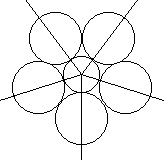| F° | C° | Action | Graph |
| 32 | 0 | Water Freezes/Melts |
 |
| 212 | 100 | Water Boils/Steam Condenses | |
| 400 | 204 | Bake muffins, cook pancakes, fry potatoes | |
| 450 | 232 | Tin (Sn) Melts | |
| 585 | 307 | Pewter Melts (Swest)(Old pewter 80 Pb, 20 Sn) | |
| 621 | 327 | Lead (Pb) Melts | |
| 786 | 419 | Zinc (Zn) Melts | |
900 |
482 |
Art Glass Anneal Point, Faint Red Heat* | |
| 1063 | 573 | Quartz Inversion Temperature - abrupt expansion of glass & clay | |
| 1086 | 586 | Cone 022* | |
| 1100 | 593 | Plate Glass Sags | |
| 1218 | 659 | Aluminum Melts | |
1250 |
677 |
Bullseye fusing glass softens/slumps, Med. Cherry Red Heat | |
|
1375 |
750 |
Work mild steel from forge, Cherry Red Heat* |
|
| 1500 | 816 | Pyrex Softens/Slumps | |
| 1540 | 838 | Cone 014* | |
| 1550 | 850 | Bright Red Heat | |
| 1675 | 913 | Bronze (90 Cu 10 Tin) Melts (mid-range) | |
| 1706 | 960 | Brass (85 Cu 15 Zinc) Melts (mid-range) | |
| 1762 | 961 | Fine Silver Melts | |
| 1825 | 990 | Lemon Yellow Heat* | |
| 1945 | 1060 | Bronze (96 Cu, 4 Sn) melts | |
| 1946 | 1063 | Gold Melts | |
| 1981 | 1083 | Copper Melts, Light Yellow Heat* | |
| 1994 | 1090 | Cone 03* | |
| 2030 | 1110 | Nickel Silver (65 Cu, 17 Zn, 18 Ni) melts | |
| 2050-2100 | 1121-1149 | Furnace Art Glass working temp | |
| 2200 | 1200 | White Heat*, Cone 5* | |
|
2232 |
1222 |
Cone 6* | |
2286 |
1252 |
Pyrex "working temp" 1000 poises (to 2600F) | |
| 2300 | 1260 | Cast Iron (C+Si+Mn+Fe) Melts | |
| 2381 | 1305 | Cone 10* | |
| 2400 | 1315 | Spruce Pine Batch Cooking Temp | |
| 2480 | 1360 | Monel (33 Cu, 60 Ni, 7 Fe) melts | |
| 2500 | 1353 | Steel-High Carbon Melts | |
| 2540 | 1393 | Inconel Ni+Cr+Fe | |
| 2550 | 1363 | Stainless Steel Melts | |
| 2588 | 1420 | Silicon Melts | |
| 2600 | 1427 | Medium Carbon Steel Melts | |
| 2651 | 1455 | Nickel (Ni) Melts | |
| 2700 | 1464 | Low Carbon Steel Melts | |
| 2786 | 1530 | Iron Melts | |
| 3034 | 1615 | Chromium Cr | |
| 3110 | 1710 | Quartz Melts (for cristobalite)(details) | |
| 3222 | 1769 | Platinum Melts | |
| 3263 | 1795 | Titanium Ti | |
| 3434 | 1890 | Chromium Melts (jewelry book) | |
| 3632 | 2000 | Quartz Melted Approx. (glass or fused quartz) | |
|
3722 |
2050 |
Alumina Al2O3(MF) |
|
| 4046 | 2230 | Quartz boiling point (details) | |
| 4800 | 2620 | Molybdenum Melts (used in quartz melting crucibles) | |
| 5432 | 3000 | Tungsten Melts | |
| 6512 | 3600 | Carbon Melts (in non-oxidizing atmosphere) | |
| * Heat color temps are approx. & depend on
lighting, and F<>C is not exact.
Metal Temperature by Color or this chart of color examples in iron http://www.blksmth.com/heat_colors.htm * Cone temps are used in pottery work and actually include the history of the heating as measured by a specific Orton Cone - a long slow heat will sag a cone at lower temp than a fast rising heat. Ceramic kilns are typically shut off as soon as the cone sags, while glass is often held (soaked) at peak temp. |
Graph Source
|
||
 If 6 wires are bound together, the hole in the
middle (7th or core wire) is exactly the same size.
If 6 wires are bound together, the hole in the
middle (7th or core wire) is exactly the same size.